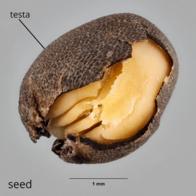Fruits and seeds form both the bulk of agricultural commerce and are common contaminants, which if introduced and colonize may lead to devastating consequences to crops and wildlands. Other plant parts that are vegetative in origin may also be contaminants, some of which if introduced to an amenable environment can grow and produce plantlets. However, those are not the focus of this tool. To learn more about vegetative propagules, see this description in the FNWD tool. Determining if a specimen is a fruit or a seed is not always straightforward, especially if only fragments are found. Although this tool was designed for that potential ambiguity, understanding fruit and seed morphology and how they might appear as contaminants will aid in interpreting the information in the fact sheets and identifying a specimen.
Plants that reproduce using seeds are classified into over 400 families and can either be flowering (angiosperms) or non-flowering (gymnosperms). A seed includes an embryo that is often surrounded by nutritive tissue and encased in and protected by an outer coat, the seed coat or testatesta:
seed coat
 . In angiosperms, the seed is protected to varying extents by the fruit wall (pericarppericarp:
. In angiosperms, the seed is protected to varying extents by the fruit wall (pericarppericarp:
fruit wall or fruit coat
), which develops from the ovary wall. Seed coat and fruit wall modifications, which primarily function to aid in dispersal, can provide clues to their identity.
Illustrations and photos used in the figures below and on the other "About fruits and seeds" pages are not to scalescale:
general term for short, thin, flat bracts or hairs
.